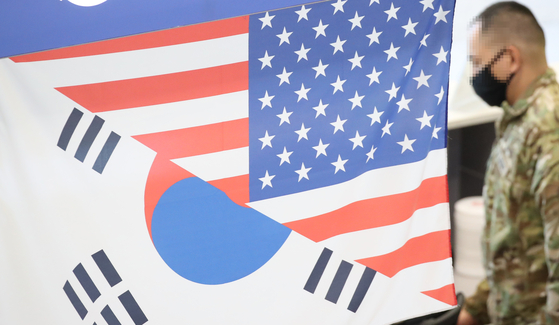![The Wall Street Journal reported on the 26th (local time) that the ROK-U.S. and the United States are close to signing a new defense cost share special administration. The media reported that a five-year contract is influential in terms of the form of Gyeyang, citing sources from both governments. [연합뉴스]](https://i0.wp.com/pds.joins.com/news/component/htmlphoto_mmdata/202102/27/48342a14-d333-4b28-81f7-cbad984c0206.jpg?w=560&ssl=1)
The Wall Street Journal reported on the 26th (local time) that the ROK-U.S. and the United States are close to signing a new defense cost share special administration. The media reported that a five-year contract is influential in terms of the form of Gyeyang, citing sources from both governments. [연합뉴스]
It was observed that both sides of the ROK and the United States agreed on the details of the 11th Special Agreement on Defense Cost Shares (SMA) for the USFK, and that an agreement will be reached sooner or later. The ‘13% increase plan’, which was agreed at last year’s working line but fell at the last minute against former President Donald Trump, is being widely discussed. The Wall Street Journal (WSJ) on the 26th (local time) “The US and South Korea have approached an agreement to settle years of disputes over the issue of defense cost sharing.”Reported. This medium is Quoting sources from the Korean-US government, they said that it is highly likely to be concluded with a 5-year contract with an increase of 13%.
WSJ “close to the conclusion of the five-year agreement”
Will the strengthening of the biden alliance be reflected?
Trump rejects ‘13% increase’ power
According to the WSJ, the issue of Korea-US negotiations was the question of who would pay the 2 billion dollar (about 2.5 trillion won) cost of maintaining about 28,500 US troops in Korea. Currently, Korea is paying about half of the cost of maintaining USFK. The ROK-US negotiation team reached a provisional agreement on a plan to raise the contribution in 2020 by 13% from the previous year’s contribution (1.389 trillion won) in March last year, but the President at the time of Trump refused to reach a final agreement and returned to the original point. .
The U.S. Department of State also expressed its willingness to conclude a defense cost share agreement. An official from the State Department’s spokesman’s office told the Voice of the United States on the day, “The US-Korea alliance is the core axis of peace, security, and prosperity in Northeast Asia, the free and open Indo-Pacific, and the world.” “We are fully committed to finalizing the renewed Special Agreement on Defense Expenses, which will strengthen the government.”
Contribution Agreement, 13%·5 Years Stranded?

USFK defense cost share trend. Graphic = Reporter [email protected]
In March last year, during the days of the Trump administration, the US-Korea negotiating team reached an interim agreement on a plan to increase the 2020 contribution by 13% from the previous year’s contribution (1.389 trillion won). However, as President Trump refused to take the total amount as a problem, negotiations on ROK-US defense cost contributions continued to be unfinished. However, the Biden administration is said to have formed a consensus in a large framework for the 13% increase proposed by South Korea. Earlier, an official from the Ministry of Foreign Affairs said, “In accordance with the spirit of the ROK-US alliance, the two sides agree to pursue a settlement as early as possible.” “The atmosphere of (negotiation) is not bad and we are in close communication with the US.” said.
It is analyzed that the reason why the ROK-US defense share agreement has accelerated since the inauguration of the Biden administration is because the US uses the USFK cost issue as a means to strengthen ties with the alliance instead of a transactional approach. Real again US President Joe Biden said in a speech at the Munich Security Conference (MSC) held on video on the 19th, emphasizing the multilateral diplomatic policy of the United States and promising that he “will not see the alliance from a transaction point of view.”
WSJ reported that a five-year contract is strong as to the form of negotiation. therefore “Signing a five-year contract agreement will make it easier for the US to coordinate its military efforts with South Korea and cooperate with South Korea on other issues important to the US, including cooperation for collective defense.”Analyzed.
Increase rate’cap’ is also an important variable
![If the defense cost sharing agreement is concluded in the form of a five-year contract, whether or not a cap (upper limit) is applied to the annual increase rate is also an important variable. [연합뉴스]](https://i0.wp.com/pds.joins.com/news/component/htmlphoto_mmdata/202102/27/964c0878-8917-4b40-bdd8-90b1e41f8a33.jpg?w=560&ssl=1)
If the defense cost sharing agreement is concluded in the form of a five-year contract, whether or not a cap (upper limit) is applied to the annual increase rate is also an important variable. [연합뉴스]
When the defense cost-sharing agreement is concluded in the form of a five-year contract, the annual increase rate is the main variable. In the ninth negotiations concluded at the time of the Obama administration in 2014, the contributions paid by Korea were raised in consideration of the inflation rate each year, but the cap was capped so that the upper limit does not exceed 4%. Controversy over the rate of increase also arose when the Trump administration proposed a 13% increase in defense spending in the first year. This is because if the increase is increased by 7 to 8% every year from the following year after raising 13% in the first year, the result is an increase of about 50% in the fifth year, the last year.
Earlier, the US and Japanese governments decided to extend the special agreement on US military defense costs in Japan on the 17th by one year. Regarding the increase rate, the U.S. and Japan agreed to a slight increase of 1.2% from the previous year (fiscal year 2020) to the share borne by the Japanese government for this fiscal year to 2017 billion yen (2.134.5 billion won).
Reporter Jeong Jin-woo [email protected]
![]()
